Although I went to sleep rather early, I was still surprised when the next morning I woke up in the hotel room I took in village Quiriguá, Guatemala, around 5.30 am! Admittedly, I was helped in this by local roosters and some birds, but I still kept trying to continue with my sleep. I even fitted my earplugs, but it did not work. And then the village started to be flown over by an airplane and even the earplugs could not help with this. Yes, it definitely sounded like a small plane that buzzed several times over us, so regardless of any possible morning unclarity of mind there was no error in my assessment. But, the point is not about the source of noise, but about the fact that this was all happening between 5.45 and 6.15 am!!!
At around this time I decided not to bother any more trying futilely to fall asleep again and that it would be better if I simply got up and slowly got prepared for the rest of the day.
And so, already around 7 am I went out and that was enough since there was a bus stop right in front of the hotel. Only a dozen minutes later a passenger van arrived that soon got onto the main road where it continued in the direction of the Caribbean coast, but I covered only a few kilometres in it before I had to get off, since I had to change in order to go along a side road. I did not wait there for long either and soon came a passenger van by which I covered additional 3.5 km and then I finally reached the entrance to the archaeological site of Quiriguá. It was still not 8 am when the site opens, so I had to wait a little. Apart from me there was also a young local couple who seemed very much in love and it appeared that the only thing they care about in this world was the other person. I wondered why they had decided to come right here and so early.
Be as it may, the guy who was selling the tickets let us enter the site before 8 and as the other two seemed to have only romantic motives, I was practically all alone during the sightseeing. Admittedly, there were some men working on the maintenance and probably guarding of the site, but the sensation was great nonetheless. Although Quiriguá is a very important the archaeological site of the ancient Maya people, moreover, it is inscribed on the UNESCO’s World Heritage List, it was my impression that it is not very popular among tourists. Perhaps this is so because it is slightly tucked away or perhaps because in comparison to Tikal, the other important Mayan site in Guatemala, Quiriguá seems too modest, pale and insufficiently impressive and grand. But, this may apply to common tourists and not to an experienced traveller, adventurer and prime connoisseur of the Maya civilisation such as I.
Joking aside, Quiriguá was inhabited already since the 2nd century CE and the archaeologist have mostly managed to follow its development with occasional hiatuses, the periods on which there is no data, but during the reign of its greatest ruler name Kʼakʼ Tiliw Chan Yopaat or Cauak Sky (723-785) this Mayan city-state reached its peak. Quiriguá is located on a very important trading route that connected Tikal and the Mayan cities further up north, on the one side, and, on the other, Copán and other Mayan centres in the southern parts of the region which this nation inhabited in the first millennium of the Common Era. It is precisely the first millennium, or more accurately the period from 200 to 900 CE, that constitutes the Classic Period in the development of Maya civilisation.
At the time when Cauak Sky ascended to the throne, Quiriguá was a vassal of Copán, but over time he refused to continue to be an obedient local leader and declared himself to be the holy lord (k’ul ajaw) instead of merely a lord (ajaw). As I’ve mentioned before, the ajaw was the standard title used by the rulers of the city-states of the ancient Maya people. These events took place during the reign of the greatest ruler of Copán, 18 Rabbit, who, of course, could not allow such impertinence, especially since it was him personally to put Cauak Sky on the throne of Quiriguá. However, under unclear circumstances, 18 Rabbit was captured by Cauak Sky and in 738 sacrificed at the Great Plaza in Quiriguá by having his head severed. Cauak Sky continued to rule and carry the title of his choice until 785, while Quiriguá succeeded in preserving its independence, although it never became a great city like Copán. It is believed that during this period it had around 2000 inhabitants.
On the other hand, this was all happening at the time when the end of the Classic Period of the Maya civilisation was getting close to its end. After Cauak Sky, there are records of the names of two more rulers of Quiriguá, but after 810 CE nobody else is mentioned. However, there is evidence that Quiriguá was inhabited also during the Postclassic Period (c. 900 to c. 1200 CE), but then it all slowly dies out, Quiriguá is abandoned and covered in dense rainforest, up until the official discovery of the ruins in 1840.
By the way, when it is generally talked about the decline or the end of the Maya civilisation in this part of the present-day Central America, the researchers have in mind the end to the monumental inscriptions and large architectural endeavours. Moreover, the disappearance of Quiriguá, as well as of Copán, from the historic scene at the beginning of the 9th century did not constitute the end of the Maya civilisation, but rather only a transfer of power and the centres of power from the south areas to north Yucatan where the centres like Chichén Itzá and Uxmal began to flourish. On top of this, in these new powerful Mayan city-states, completely different artistic and architectural styles were applied which entailed a significantly smaller quantity of monumental ideogrammic inscriptions.
But, let me now go back to the archaeological site of Quiriguá which I visited in May 2008. Although not too big, this site is particularly significant and known for its carved impressive steles and zoomorphic sculptures. Thanks to the large number of ideograms, these monuments carved between 426 CE and 810 CE constitute an exceptionally important source for the study of the Mayan civilisation.
As soon as one enters the site, one comes across Stele A erected in 775 by ruler Cauak Sky. Stele A, just like the nearby Stele C made in the same year, shows ruler Cauac Sky himself. In Stele A, the ruler holds a ceremonial bar in his hands which on both ends has a serpent head.
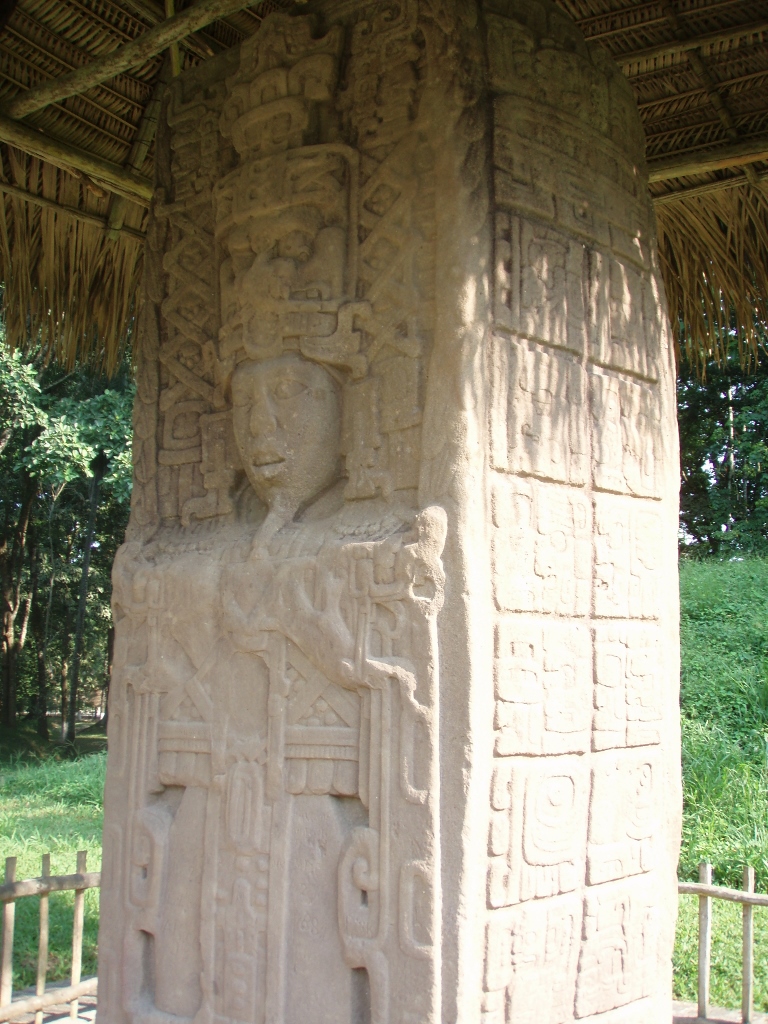 Stele A
Stele A
When I walked around the stele, to my horror I noticed that some idiots from the past (and there are certainly more of them in the present, as well) felt the need to leave their names or the year of visit or whatever engraved in this stele.
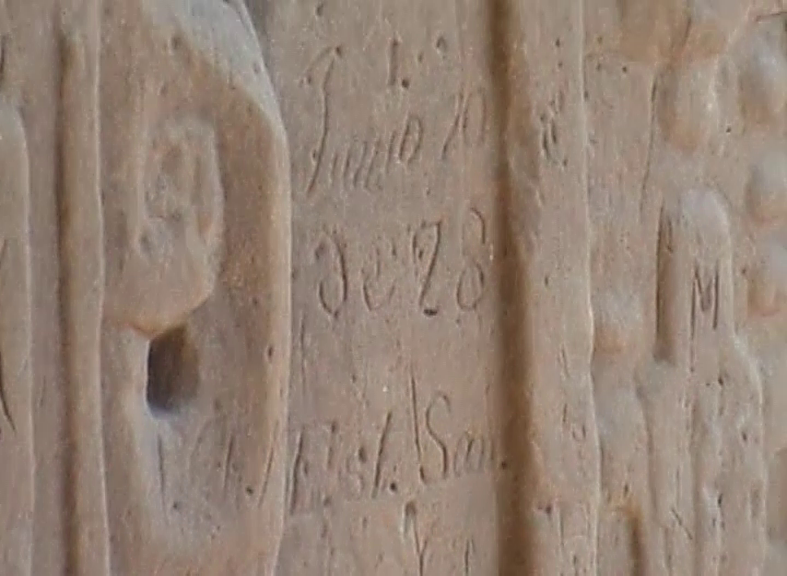 Traces of vandalism on Stele A
Traces of vandalism on Stele A
Stele C is interesting for it describes in details the Mayan myth of the creation of the world, which is particularly important for the researchers and historians. I don’t understand the language of the Mayas, even less their ideograms, so I just walked around these two steles occasionally looking in the direction of the Great Plaza in Quiriguá which, by the way, is the biggest known public space in the entire ancient Maya world.
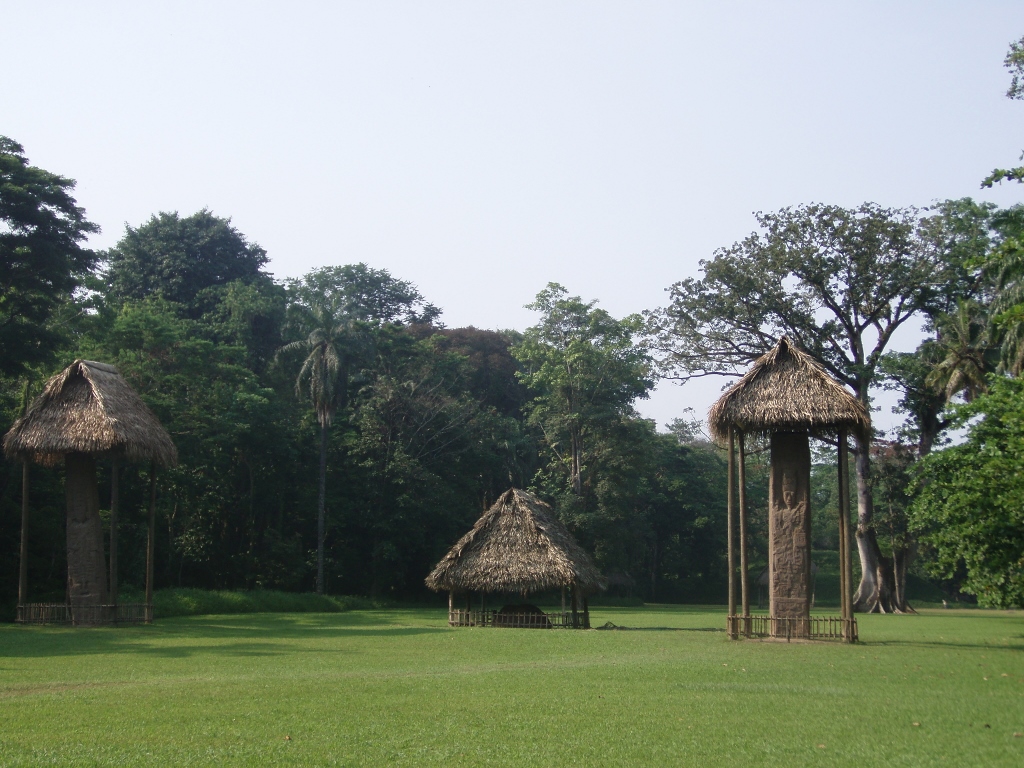 Great Plaza in Quiriguá: Stele F (left), Zoomorph G (middle) and Stele E (right)
Great Plaza in Quiriguá: Stele F (left), Zoomorph G (middle) and Stele E (right)
Still, before going to Stele E, which is particularly important, I went first to Stele D, a couple of metres farther, once again looking in the direction of Steles A and C. By the way, in the foreground of the following photo (to the left), it is possible to see the lateral side of Stele C and so if somebody reads Mayan they can see what myth this is all about.
 Stele C (left), Stele A (right) and Zoomorph B behind Stele C je
Stele C (left), Stele A (right) and Zoomorph B behind Stele C je
Stele D also shows ruler Cauac Sky. Because of the precise calculation of time and keeping the records about it, like in the case of many other monuments, here too the researchers could determine the day when the stele was erected – 17 February 766. The reliefs on one side have been very well preserved, but on the other some details have been lost over time. This also clearly shows the need for the thatch canopies that are placed above the steles and zoomorphs at the site, for in this way they are protected against further erosion.
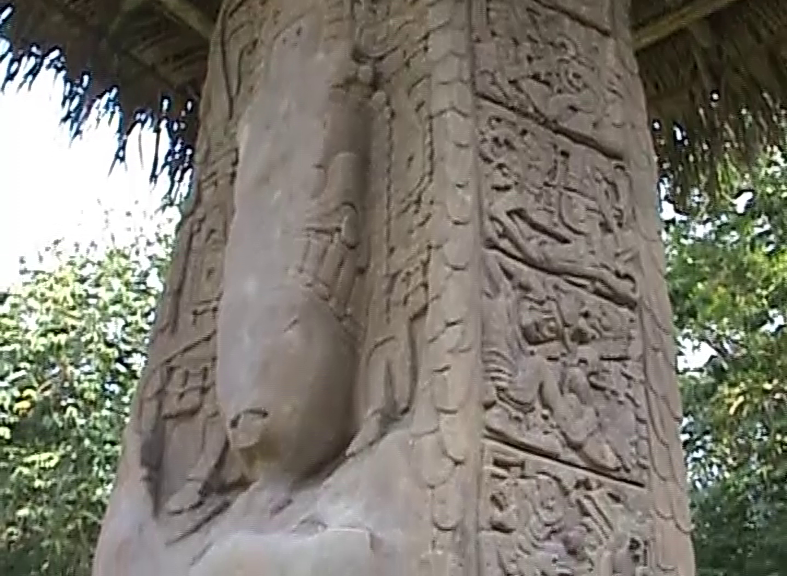 Stele D, the eroded side
Stele D, the eroded side
Here I paid a little more attention to the different depictions that decorate the lateral sides of Stele D. More accurately, in the upper section there are more complex images and depictions that show anthropomorphic versions of Mayan ideograms, which is a relatively rare thing, while in the lower section there are carved typical Mayan ideograms.
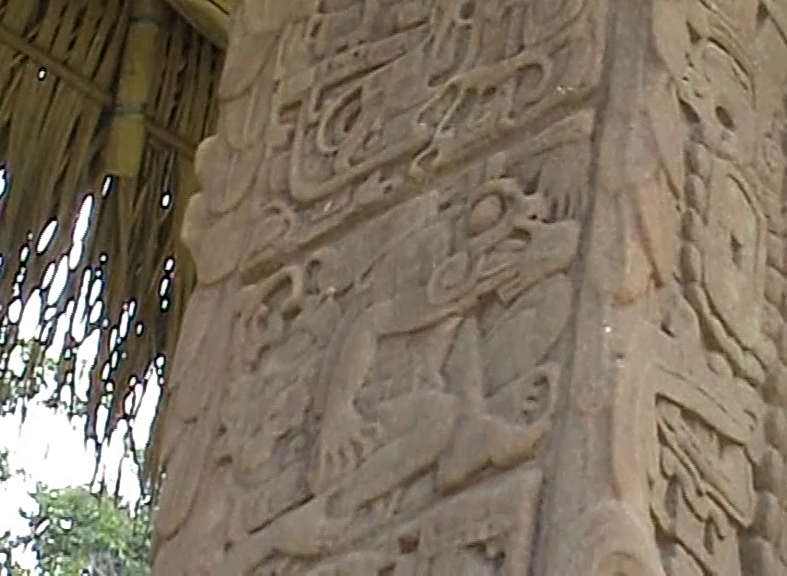 Stele D, depiction on the lateral side
Stele D, depiction on the lateral side
 Stele D, depiction on the lateral side
Stele D, depiction on the lateral side
 Stele D, depiction on the lateral side
Stele D, depiction on the lateral side
 Stele D, on the left there is the lower part of the body of the ruler wearing an apron, the ideograms are to the right
Stele D, on the left there is the lower part of the body of the ruler wearing an apron, the ideograms are to the right
After these three steles, I also went to Zoomorph B. To start with, the term zoomorph is used here for enormous carved monoliths that generally show a deity in the shape of an animal. Zoomorph B is considered one of the more important monuments of this type in Quiriguá and it was dedicated by Cauac Sky in 780. This large boulder contains in fact a myriad of elements and perfectly fitted depictions of three specific animals (jaguar, serpent and crocodile) that are linked precisely to the myth of the creation of the world and three stones that are mentioned in that myth. Also, on the front side it is possible to see the head of ruler Cauak Sky protruding from the jaws of the jaguar and the serpent (the depictions of these two animals intertwine exceptionally imaginatively). All of this also reminds of a turtle shell from which the head of the ruler peers, which all together symbolises the birth of the ruler as the First Father. Unfortunately, it is difficult with an ordinary photograph, without a reference object, to illustrate the 4 metres of the length of this zoomorph.
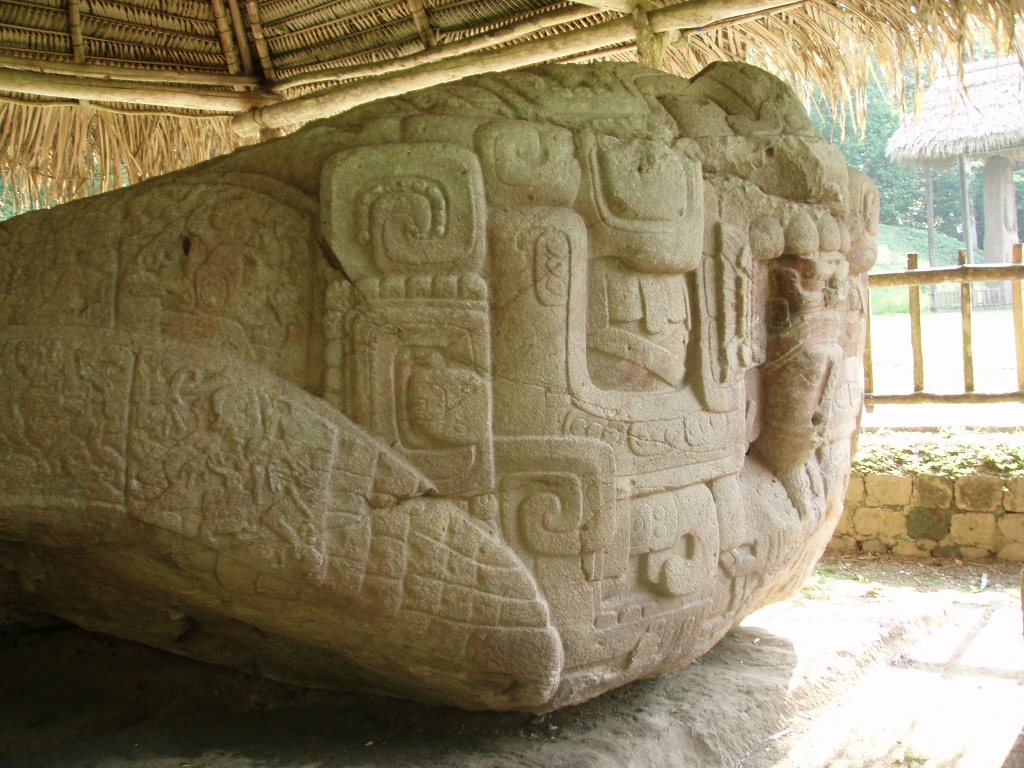 Zoomorph B, the head of the ruler in semi-profile can be seen on the right-hand side in the middle
Zoomorph B, the head of the ruler in semi-profile can be seen on the right-hand side in the middle
After this it was the time to move on and that entailed more steles and more zoomorphs.
 Zoomorph G (left) and Stele E (right)
Zoomorph G (left) and Stele E (right)
First I walked to Stele F from 761 CE. At the time when it was made, with its height of 7.3 m, it was the tallest monument built by the Maya until then. Ten years later, its height was surpassed. Nowadays, this stele is slightly askew, however, the inscriptions on its lateral sides are superb.
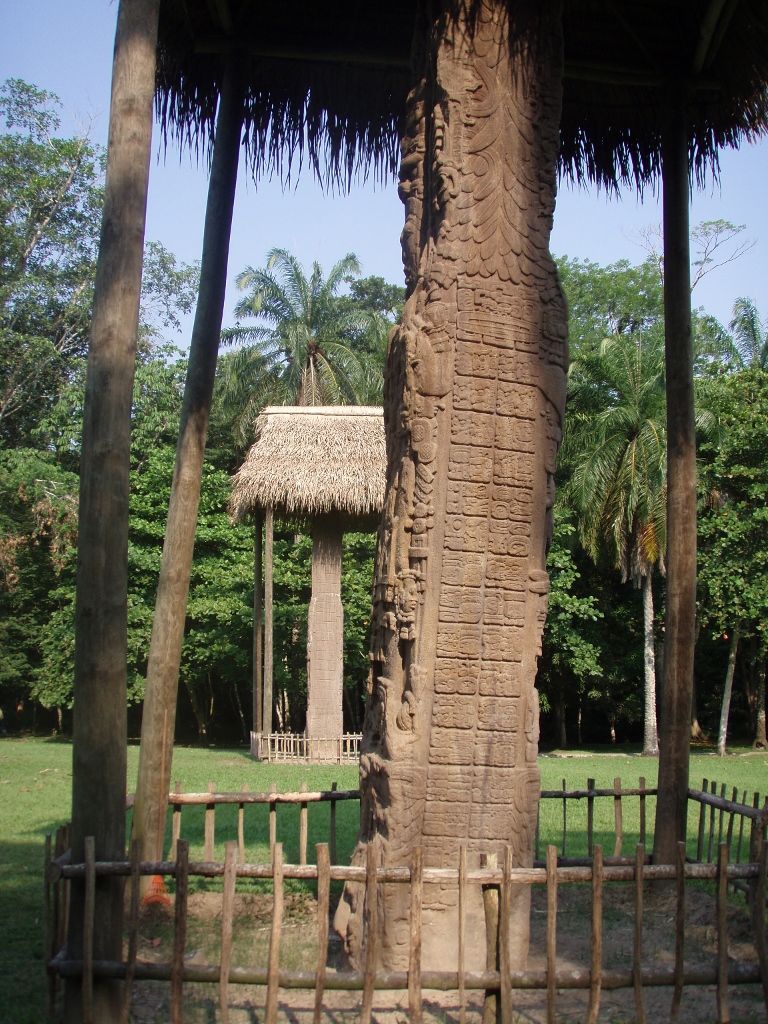 Stele F, with Stele E in the background
Stele F, with Stele E in the background
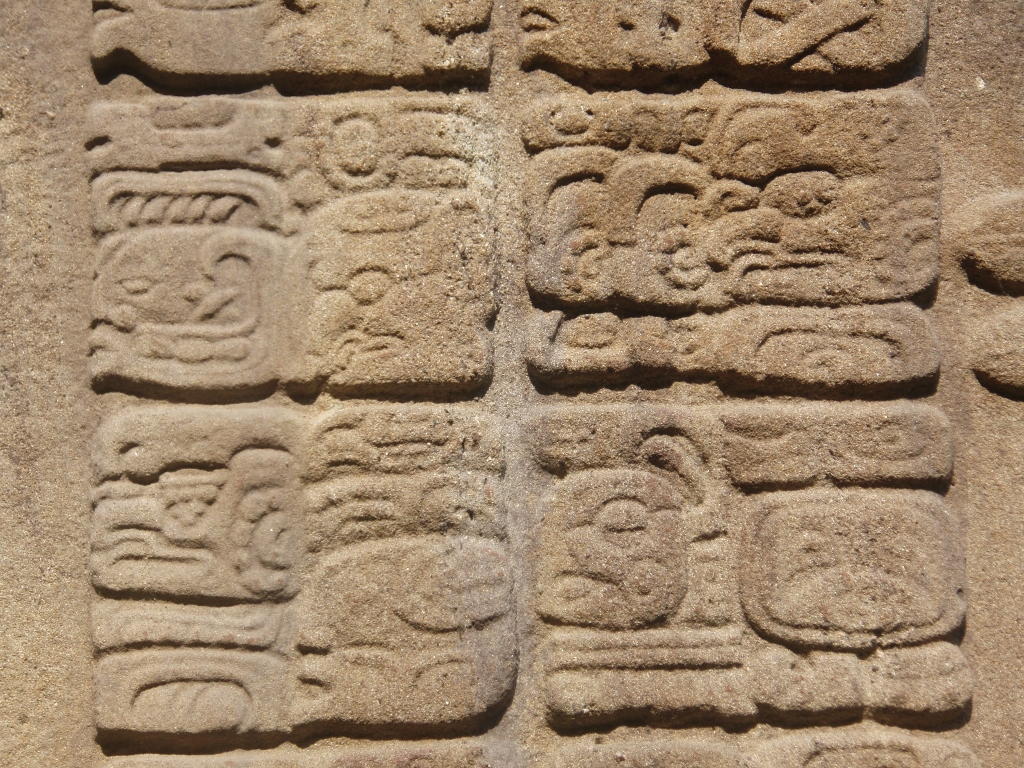 Ideograms on Stele F
Ideograms on Stele F
And then I got to the nearby Stele E which ruler Cauac Sky dedicated in 771. This is the tallest stele not only here in Quiriguá, but in the entire Maya world. It is 10.6 m high, with 3 m being under the ground, which means that around 7.5 m can be seen above the ground. At the time when this stele was dedicated Quiriguá was no longer subjugated to Copán, but was rather quite independent and it is presumed that by erecting such a large monument that could be seen from the Motagua river used as the main route for the entire trading in the Mayan world the greatest king of Quiriguá made clear to all not only the importance of Quiriguá, but of himself as well.
 Stele E – the beauty of a reference object 1.8 m tall; one can immediately see better how impressive this is
Stele E – the beauty of a reference object 1.8 m tall; one can immediately see better how impressive this is
This enormous monolith is the biggest piece of rock ever carved in the ancient Maya civilisation. Like in the case of the other steles in Quiriguá, this is also sandstone that is a soft type of rock, but this outstanding feat of the Maya is that much greater when you know that they did not use metal tools. In addition, the raising of the stele to the upright position is a huge success by itself, for the stele weighs 65 tons. Namely, the Mayas did not use a wheel or draught animals. In order to comprehend even better the enormity of the accomplishment of the ancient Maya, specifically using the example of Stele E, it should be said that after the centuries of heavy rains, Stele E was tilting at the beginning of the 20th century and then it eventually collapsed in 1917, but remained intact. In 1934, they started to put it upright again using the winch and steel cables, but the cables broke, the monument fell and halved. It was later joined together using concrete and then it was positioned upright. So, on the one side we have the ancient Mayas and their crude methods from the 8th century and on the other we have the 20th century.
Needless to say, Stele E shows ruler Cauac Sky.
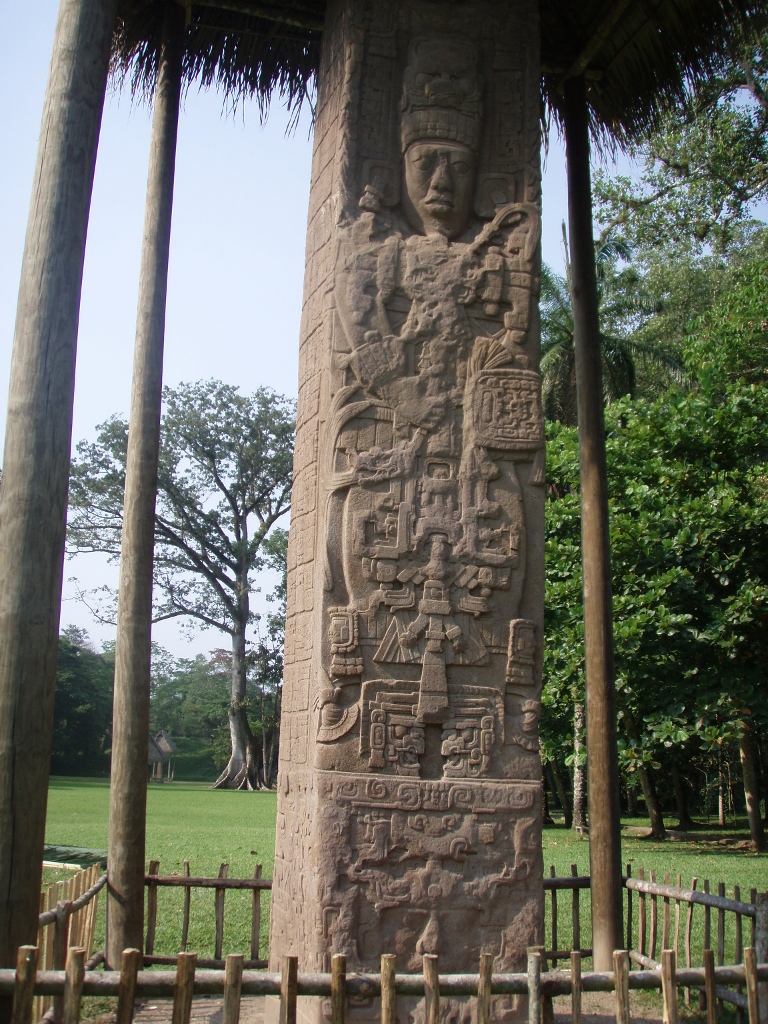 Stele E
Stele E
Close to Steles E and F there is Zoomorph G. This is again a complex relief depiction that resembles an amphibian through the mouth of which comes out the head of the ruler and like in the case of Zoomorph B here it is also possible to see elements that belong to different animals including both jaguar and crocodile. This zoomorph was dedicated in 785, only 85 days after the passing of the great ruler Cauac Sky whose head is shown protruding from the jaws of the beast. In this way, the zoomorph also constitutes a memorial to this ruler who reigned during, for the time, incredible 61 years (724-785). When I was here, the workers were repairing the roof of the canopy above Zoomorph G.
 Repair of the roof over Zoomorph G, with Stele F in the background
Repair of the roof over Zoomorph G, with Stele F in the background
I continued with my walk around the site and at some point I turned back and looked at the Great Plaza which I had already covered.
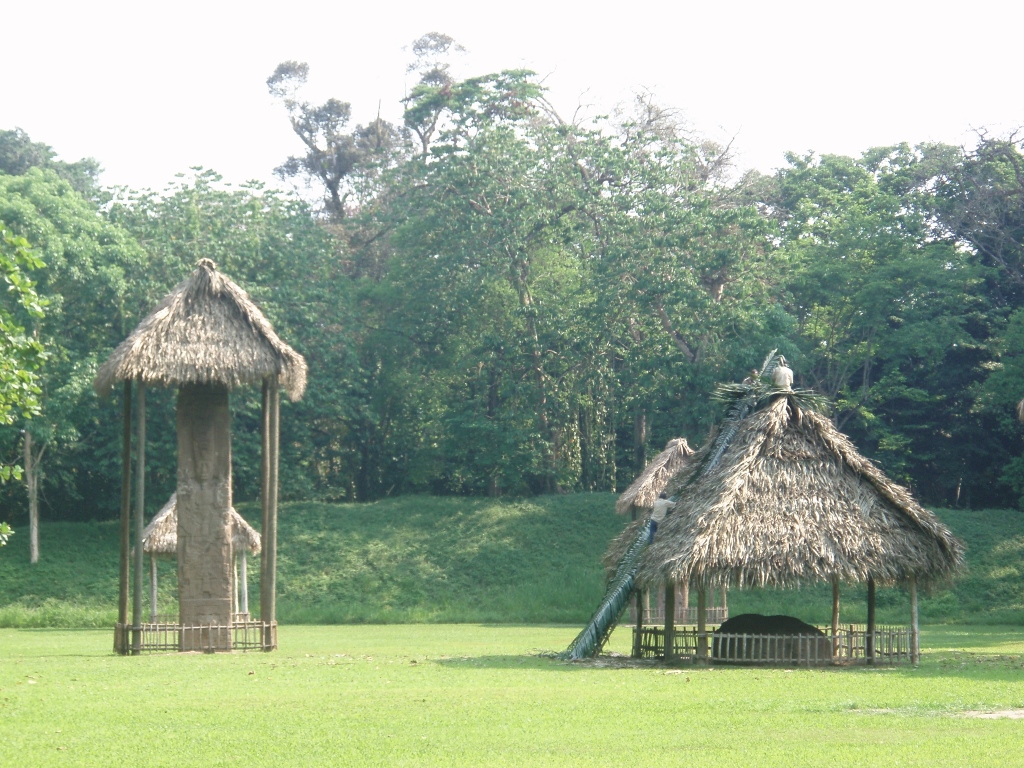 Stele E (left) and Zoomorph G (right)
Stele E (left) and Zoomorph G (right)
And then I came across something wonderful – an impressive, huge... tree. I had to find a way to show its extraordinariness, so I placed my camera on my small backpack that I put down on the ground, set it to make the shot after 10 seconds and they ran like crazy to the tree. It did not work our right away, so I had to repeat the whole thing a few times, perspiring profusely while doing that, for although it was still early in the morning the temperature was rising and the air humidity was constantly very high. Still, it was worth it.
 Fantastic tree in the middle of the Great Plaza in Quiriguá
Fantastic tree in the middle of the Great Plaza in Quiriguá